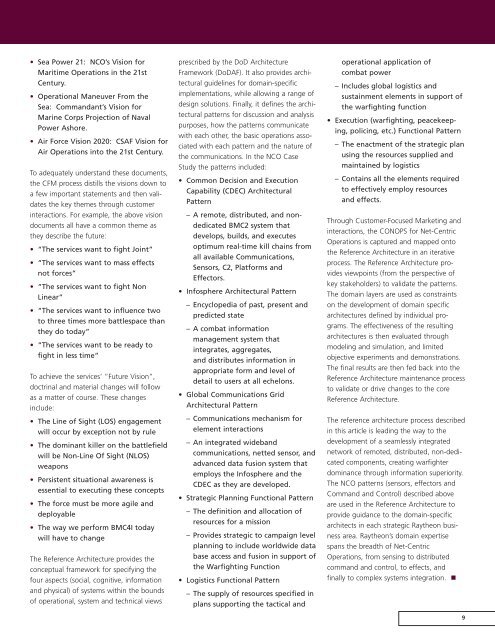TT_Vol3 Issue2 - Raytheon
TT_Vol3 Issue2 - Raytheon
TT_Vol3 Issue2 - Raytheon
You also want an ePaper? Increase the reach of your titles
YUMPU automatically turns print PDFs into web optimized ePapers that Google loves.
• Sea Power 21: NCO’s Vision for<br />
Maritime Operations in the 21st<br />
Century.<br />
• Operational Maneuver From the<br />
Sea: Commandant’s Vision for<br />
Marine Corps Projection of Naval<br />
Power Ashore.<br />
• Air Force Vision 2020: CSAF Vision for<br />
Air Operations into the 21st Century.<br />
To adequately understand these documents,<br />
the CFM process distills the visions down to<br />
a few important statements and then validates<br />
the key themes through customer<br />
interactions. For example, the above vision<br />
documents all have a common theme as<br />
they describe the future:<br />
• “The services want to fight Joint”<br />
• “The services want to mass effects<br />
not forces”<br />
• “The services want to fight Non<br />
Linear”<br />
• “The services want to influence two<br />
to three times more battlespace than<br />
they do today”<br />
• “The services want to be ready to<br />
fight in less time”<br />
To achieve the services’ “Future Vision”,<br />
doctrinal and material changes will follow<br />
as a matter of course. These changes<br />
include:<br />
• The Line of Sight (LOS) engagement<br />
will occur by exception not by rule<br />
• The dominant killer on the battlefield<br />
will be Non-Line Of Sight (NLOS)<br />
weapons<br />
• Persistent situational awareness is<br />
essential to executing these concepts<br />
• The force must be more agile and<br />
deployable<br />
• The way we perform BMC4I today<br />
will have to change<br />
The Reference Architecture provides the<br />
conceptual framework for specifying the<br />
four aspects (social, cognitive, information<br />
and physical) of systems within the bounds<br />
of operational, system and technical views<br />
prescribed by the DoD Architecture<br />
Framework (DoDAF). It also provides architectural<br />
guidelines for domain-specific<br />
implementations, while allowing a range of<br />
design solutions. Finally, it defines the architectural<br />
patterns for discussion and analysis<br />
purposes, how the patterns communicate<br />
with each other, the basic operations associated<br />
with each pattern and the nature of<br />
the communications. In the NCO Case<br />
Study the patterns included:<br />
• Common Decision and Execution<br />
Capability (CDEC) Architectural<br />
Pattern<br />
– A remote, distributed, and nondedicated<br />
BMC2 system that<br />
develops, builds, and executes<br />
optimum real-time kill chains from<br />
all available Communications,<br />
Sensors, C2, Platforms and<br />
Effectors.<br />
• Infosphere Architectural Pattern<br />
– Encyclopedia of past, present and<br />
predicted state<br />
– A combat information<br />
management system that<br />
integrates, aggregates,<br />
and distributes information in<br />
appropriate form and level of<br />
detail to users at all echelons.<br />
• Global Communications Grid<br />
Architectural Pattern<br />
– Communications mechanism for<br />
element interactions<br />
– An integrated wideband<br />
communications, netted sensor, and<br />
advanced data fusion system that<br />
employs the Infosphere and the<br />
CDEC as they are developed.<br />
• Strategic Planning Functional Pattern<br />
– The definition and allocation of<br />
resources for a mission<br />
– Provides strategic to campaign level<br />
planning to include worldwide data<br />
base access and fusion in support of<br />
the Warfighting Function<br />
• Logistics Functional Pattern<br />
– The supply of resources specified in<br />
plans supporting the tactical and<br />
operational application of<br />
combat power<br />
– Includes global logistics and<br />
sustainment elements in support of<br />
the warfighting function<br />
• Execution (warfighting, peacekeeping,<br />
policing, etc.) Functional Pattern<br />
– The enactment of the strategic plan<br />
using the resources supplied and<br />
maintained by logistics<br />
– Contains all the elements required<br />
to effectively employ resources<br />
and effects.<br />
Through Customer-Focused Marketing and<br />
interactions, the CONOPS for Net-Centric<br />
Operations is captured and mapped onto<br />
the Reference Architecture in an iterative<br />
process. The Reference Architecture provides<br />
viewpoints (from the perspective of<br />
key stakeholders) to validate the patterns.<br />
The domain layers are used as constraints<br />
on the development of domain specific<br />
architectures defined by individual programs.<br />
The effectiveness of the resulting<br />
architectures is then evaluated through<br />
modeling and simulation, and limited<br />
objective experiments and demonstrations.<br />
The final results are then fed back into the<br />
Reference Architecture maintenance process<br />
to validate or drive changes to the core<br />
Reference Architecture.<br />
The reference architecture process described<br />
in this article is leading the way to the<br />
development of a seamlessly integrated<br />
network of remoted, distributed, non-dedicated<br />
components, creating warfighter<br />
dominance through information superiority.<br />
The NCO patterns (sensors, effectors and<br />
Command and Control) described above<br />
are used in the Reference Architecture to<br />
provide guidance to the domain-specific<br />
architects in each strategic <strong>Raytheon</strong> business<br />
area. <strong>Raytheon</strong>’s domain expertise<br />
spans the breadth of Net-Centric<br />
Operations, from sensing to distributed<br />
command and control, to effects, and<br />
finally to complex systems integration. �<br />
9
















